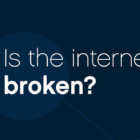
Highlights of the joint Euro-IX and AMS-IX webinar “Is the Internet broken?”
AMS-IX NEWS

Henrica Kranendonk
Events and Internal Communication Manager
18 August 2020
Last week, Henk Steenman (AMS-IX), Carlos Martinez (LACNIC), Katsuyasu Toyama (JPNAP) and Kyle Spencer (UIXP) had a panel discussion about a crucial topic: Is the Internet broken? And if so, what can exchanges do to fix them? In this 2-minute wrap-up report, you can read some of the highlights of that discussion. Or click the link the video below to view the whole webinar.
The panel discussion is the first of a webinar series organised by Euro-IX and AMS-IX about the shortcomings of the Internet, and the role exchanges have to play in driving changes. Fuel for the discussion was Henk Steenman’s paper on this issue, which he presented during AMS-IX Talks. (A long read about Henk’s ideas can be found on our website and in the AMS-IX annual report) After a quick introduction of all the panellists and an explanation by Euro-IX moderator Bijal Sanghani about the ground rules, Steenman kicked off the panel discussion with an outline of his ideas.
Build new internets
Henk Steenman underlines that the Internet brings us very good things and is one of mankind’s great achievements. Nonetheless, the Internet also definitely has some important flaws that need to be addressed. BGP hijacks, the alarming growth of DDOS attacks …. there are many problems with the current Internet that can be contributed to the design itself. There are technologies out that could be a solution, but there also seems to be an inability of the Internet to pick up and implement new technologies. The lack of pickup of IPv6 (technology from the mid-90s and still only 25-30% implemented worldwide today) and the limited use of RPKI (only 23% of all prefixes at AMS-IX are RPKI enabled), reflects this. As Steenman put it: “It is like we are still using Windows 95. We are in dire need of an upgrade.”
Steenman, therefore, proposes to start to experiment with new networking technologies in communities of interest, separated from the Internet at large. These communities will comprise of companies who have similar needs and goals. This will allow them to make and abide to their own networking rules. In his view, it is the only way to keep the decentralised structure of the Internet intact and at the same time, implement some badly needed new technologies that will enhance the quality of the internet.
The panellists responses
Katsuyasu Toyama was the first one to respond to Henk’s views. He considers them interesting but also has some concerns. In his eyes, Henk’s proposes a form of network segmentation and there are already examples of this. In China, we can already see how the government builds its version of the internet, which also has more central control from the Chinese government. In his view systems always need to be open and free and he does not see how this can be guaranteed when internets become governable in segmented communities. According to him, we should stick with the current system for implementing new technologies, however slow that may be.
Kyle Spencer also addressed the problem of segmentation. He argues that the strength of the internet protocol is that it offers economies of scale and those might not be there when you route traffic via newly formed communities. On the other hand, he also agrees with Henk that there is a slow pick up of new technologies in the current internet. (Although he wouldn’t come out as strong to say that the transition to IPv6 is a failed project.) The big challenge the internet currently faces is to come up with a way to address technical problems in the core of the internet more effectively in a non-centralised governance structure.
Carlos Martinez sees that there are initiatives in Latin America that already go into the direction of making their own communities of interest. Moreover, he says that updating and re-engineering the core of the internet is quite challenging. Though lots have been done in terms of community building, Martinez is critical of the role of international standardisation bodies. They were not always effective in landing new technologies in the past. However, Martinez also underlines that the internet resilience and compares internet technology with a road. “The cities around it may change, but the general structure and passageway stay there even centuries afterwards.”
The way forward
The last part of the discussion focused on the roles IXs have to play in order to change the Internet. Should they be driving change and come up with new technologies? Or should they just follow the ITU and other international bodies? Henk proposes an intermediate position. In his view, new technologies and initiatives should come from the IXs base of users. But an IX can play an active role in implementing and experimenting with new technologies. Kastuyasu and the others agree with this and also thinks IXs have a role to play in this. They all feel that IX’s should be more actively involved in standardisation, building communities and experimenting with new technology.
“The time of talking is over. We should start and begin to address the issues.”
You might also be interested in
Got a question?
© 2025 - Amsterdam Internet Exchange Terms of Use General Terms and Conditions Privacy Statement Glossary Page
Company Information